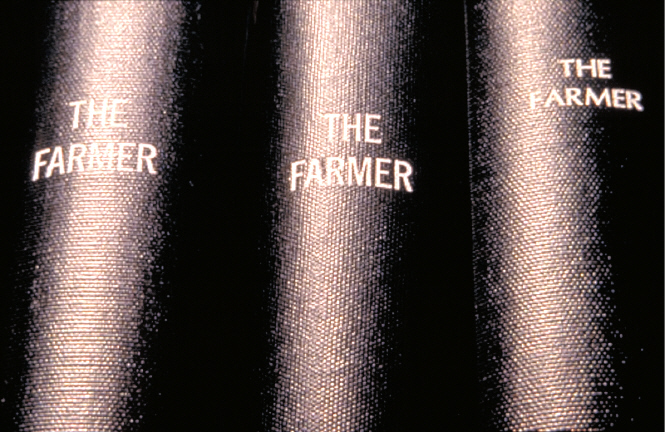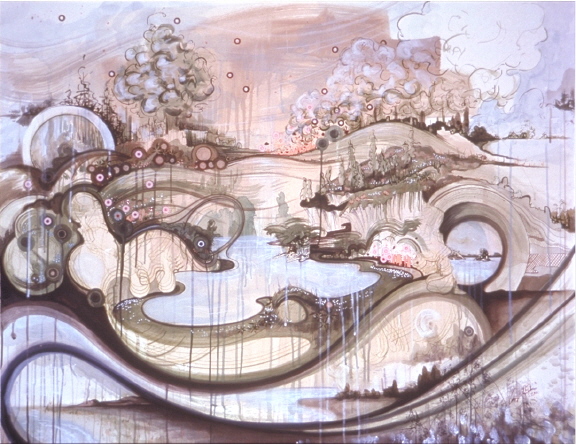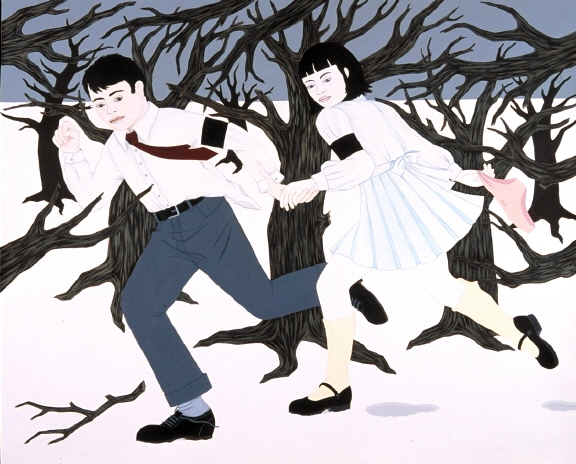The Thirty Faces of Two Dimensions: 2DII at the Minnesota Museum
Susan Clayton visited the "Minnesota Biennial: 2D II," up through December 31 at the Minnesota Museum of American Art at 50 West Kellogg Blvd., St. Paul. This juried show winnowed 30 artists out of 500: the results were mixed and interesting.




It should always be so easy: an hour to oneself, a parking space right in front, and an exhibition for which the usual admission fees are waived. Under the watchful eye of the ever-present gallery attendant I wandered alone, taking in the Minnesota Museum of American Art’s Minnesota Biennial: 2D II, third in a series that offers exhibition opportunities to Minnesota artists and the second show featuring work in two dimensions.
At times during the course of its long and varied history the St. Paul museum had been host to several acclaimed juried exhibition series. For an institution that was at the crossroads in terms of programs and resources in 2000, a return to this kind of tradition seemed a step in a good direction. With roots in the promotion of local artists and a beautiful, if somewhat hidden, exhibition space, the Museum launched a new series celebrating recent Minnesota art. The resulting Minnesota Biennial: 2D 2000 was an attractive sampling of local painting, photography, prints and mixed media. In 2002 the MMAA offered Minnesota Biennial: Sculpture and Installation. In both shows, artists both familiar and fresh were exhibited in close proximity to the Museum’s permanent collection of American art in the second-floor galleries of its then home in the venerable Landmark Center. Since that time, the MMAA has relocated to a more visible street-level downtown space.
As in 2000, the number of entrants to the biennial this year was around 500, whittled down to not quite 30 who made the installation. For what it’s worth, none of the artists included in the first show are back this year. What does an artist get for their twenty-five-buck entrance fee? Aside from a shot at a spot in a show with limited exhibition space, there’s a hint regarding a purchase award “at the discretion of the museum.” One could also make the case that an entrant is casting a vote of confidence in the MMAA’s continued efforts on behalf of local artists.
I had the opportunity to sit in on the jury process for 2D 2000. During that process –and several others that I have experienced–assistants and other bystanders are relatively silent as images are presented, except to offer helpful details to the juror on size, media, etc. Artists are generally not identified. In this way jurors can think independently, unhampered by information other than what they can see for themselves. Entering a juried show – and coughing up a fee to do so – is a roll of the dice for even the most accomplished artists: one is at the mercy of the juror’s state of mind on a given day. But the leveler is the fact that usually jurors are chosen from outside the geographic region or sponsoring institution. Jurors listed for 2D II are Elizabeth Dunbar, Curator of Kansas City’s Kemper Museum of Contemporary Art, but also an MMAA associate curator, presumably with knowledge of – and preconceived notions about – the state’s art community. I’m not sure that’s a good idea if the goal is to purely react to work submitted.
I experienced equal parts delight and boredom touring the exhibition. After digesting the somewhat anxious introductory explanation that Minnesota’s artists are worthy of attention and don’t work in a vacuum, I was thankful to encounter Patricia Olson’s Operation Mopping Up installed in the red-walled gallery that leads off the show. In this piece, mixed media panels hanging from a clothesline offer newspaper war stories and a roll call of the dead from both sides of the conflict in Iraq. These are interspersed with painted images of a woman in cowboy boots matter-of-factly mopping a bloody floor. No matter what one’s feelings about the war, the list of dead is long. Olson depicts a mop that is soaked, unwringable.
John F. Diebel makes collaged drawings in a style that suggests the art of graphic novels. Characters with profiles seemingly lifted from Spy vs. Spy are in dressed in garb from a mix of eras. They mill about together around urban structures, coaxing the viewer to concoct a narrative in which the players are identified by their medals, passports, punk chains, Stars of David.
With her pristine acrylics, Alexa Horochowski, too, invites viewers to imagine plots. There must be an explanation for the child couples she depicts in precarious situations, including plenty of iconography as story fodder. Giclees from Mickey Smith’s Volume project were fun to find. The clean photographic compositions, most made with existing light in the stacks of Minnesota libraries, monumentalize sets of bound periodicals, or at least their titles. Carol Lee Chase provides great Minnesota titles for her gently worked oil abstractions: Miles from Nowhere and Ice Cold Ice.
Gregory Euclide’s acrylic on paper How the Island Became the Mainland is the one I would take home. The piece works on many levels, appearing as a swirly, free landscape from afar, the painstakingly rendered, inky details demanding attention on closer approach. Numbered map points, direction arrows and applied elements from the office supply store plot the area, working in conjunction with paint drips. Euclide provides a place to get lost in.
Red walls turn to mauve in the far galleries. In with the really compelling work are other pieces that are merely likable: C-prints of unpeopled places, beginnings of ideas. Welcome didactic notes accompany about half the work, detailing processes such as transfer by sticky tape and drawing with the non-dominant hand. A few pieces suggest that the entry slide might have been better than the work itself.
Scanning for the artists’ home place I encountered “Minneapolis” on label after label, perhaps accurately locating the densest population of Minnesota’s working artists. Add to that a handful of St. Paulites and a shout out each from Edina, Ely, Northfield and Plymouth, the show technically spans most of the state. The vast majority of featured work is courtesy of the artist, not placed in a gallery or private collection . . . yet.
The lovely old galleries in the Landmark provided an excuse to enter that grand old building, adopting the quiet, respectful attitude suggested by polished woodwork and a lingering aura of history. But I like the new, more accessible converted parking garage space, too, and its multiple banners directing “ART HERE.” With its permanent collection in hiding, the MMAA has focused on a succession of enticing shows, but don’t look for the next year’s exhibition schedule on the website. It is unclear how long the Kellogg Street site will be available. In the meantime the Museum continues its efforts to capture the cutting edge with events such as First Friday art and music happenings. Need more cowbell? Word is that 2D II artists will be clanged offstage when time’s up during slide talks scheduled for November
17 and December 8.
RELATED EVENTS
Slide-o-rama Artist Talks are Thursday, November 17, 7-10pm; and Thursday, December 8, 7-10pm. Be there for rapid-fire presentations by the artists in the show. These are always fascinating occasions, proving that artists really can be interesting.